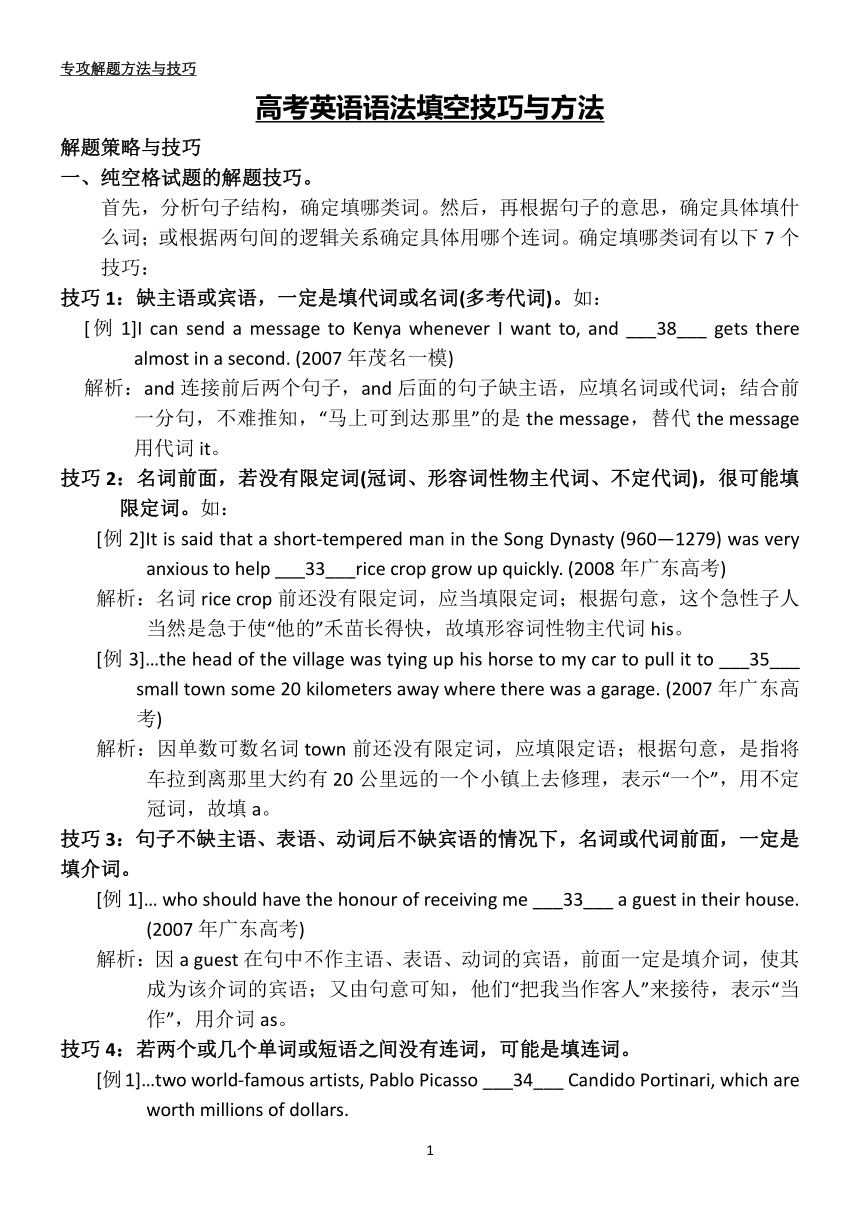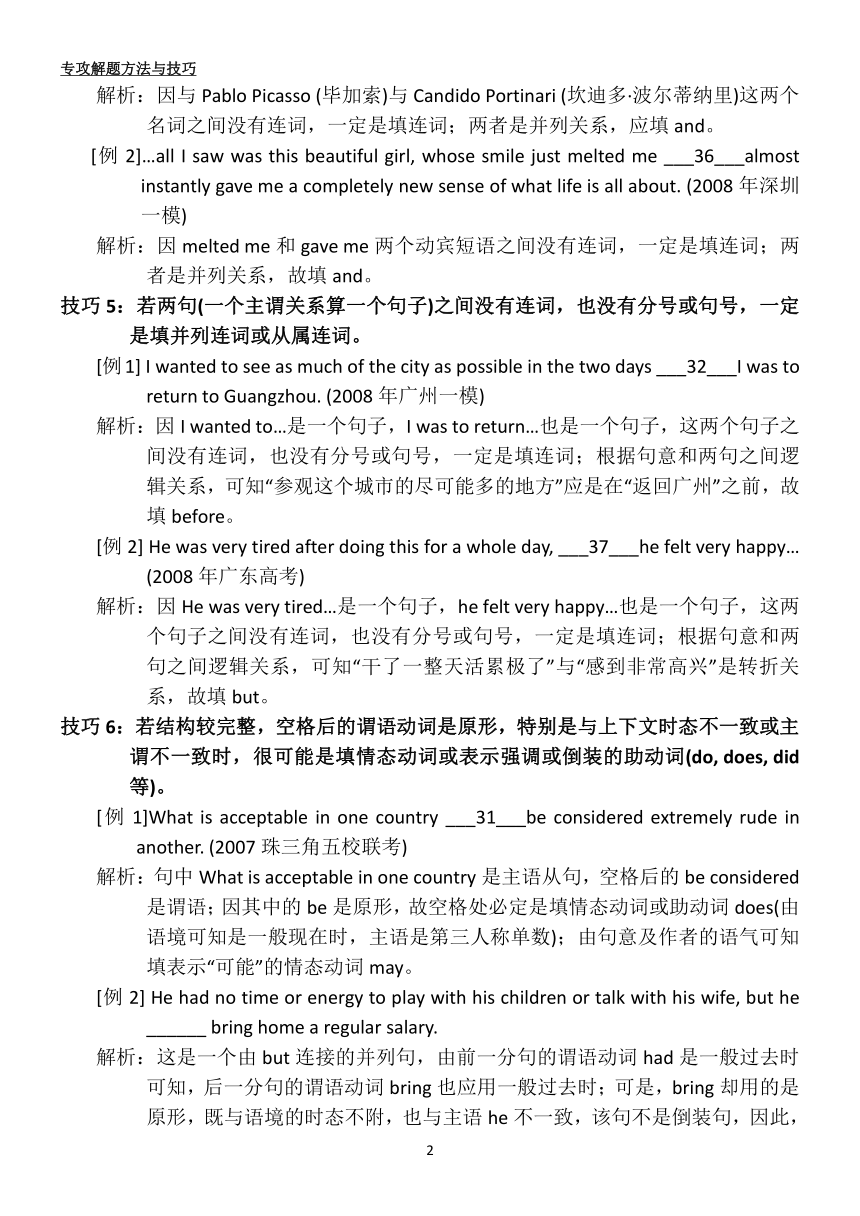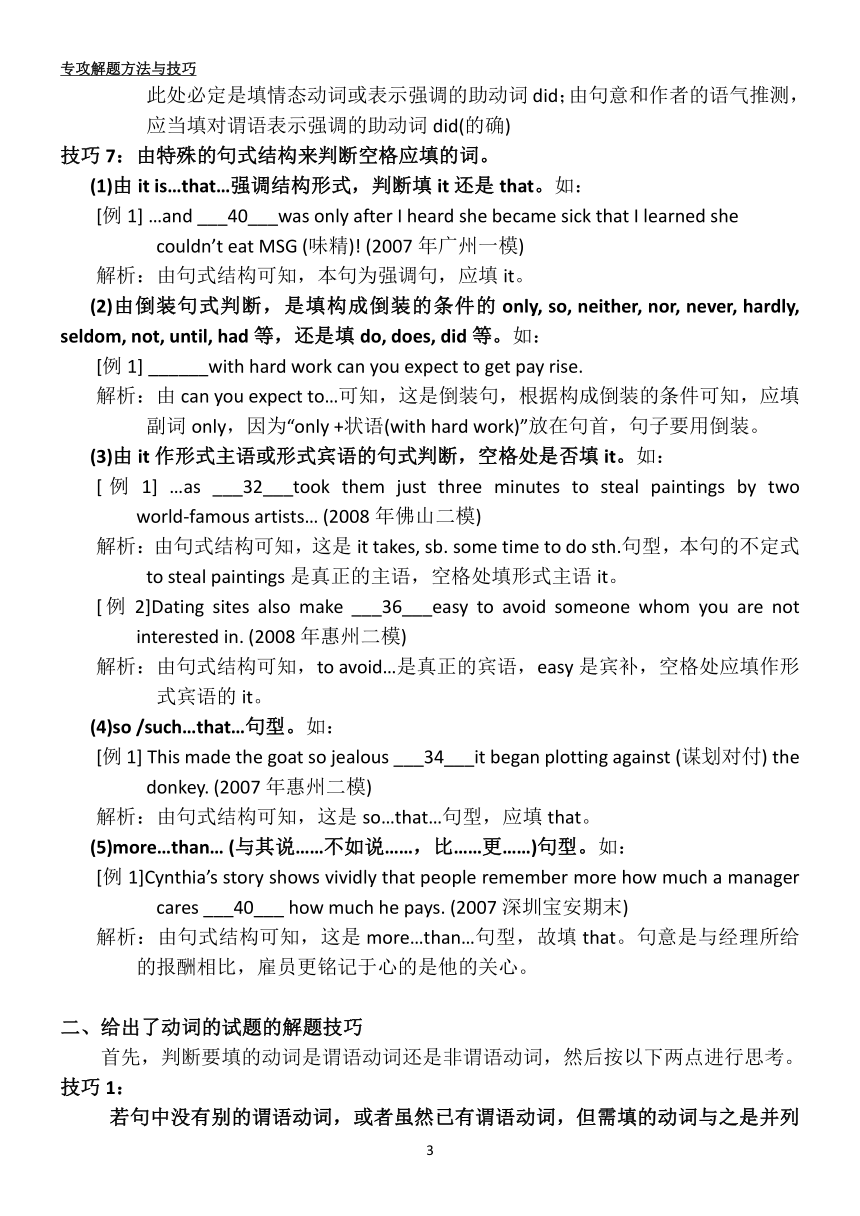高考英语语法填空技巧与方法学案(含答案)
文档属性
| 名称 | 高考英语语法填空技巧与方法学案(含答案) |

|
|
| 格式 | zip | ||
| 文件大小 | 49.6KB | ||
| 资源类型 | 教案 | ||
| 版本资源 | 人教版(2019) | ||
| 科目 | 英语 | ||
| 更新时间 | 2023-04-01 11:28:42 | ||
图片预览



文档简介
专攻解题方法与技巧
高考英语语法填空技巧与方法
解题策略与技巧
一、纯空格试题的解题技巧。
首先,分析句子结构,确定填哪类词。然后,再根据句子的意思,确定具体填什么词;或根据两句间的逻辑关系确定具体用哪个连词。确定填哪类词有以下7个技巧:
技巧1:缺主语或宾语,一定是填代词或名词(多考代词)。如:
[例1]I can send a message to Kenya whenever I want to, and ___38___ gets there almost in a second. (2007年茂名一模)
解析:and连接前后两个句子,and后面的句子缺主语,应填名词或代词;结合前一分句,不难推知,“马上可到达那里”的是the message,替代the message用代词it。
技巧2:名词前面,若没有限定词(冠词、形容词性物主代词、不定代词),很可能填限定词。如:
[例2]It is said that a short-tempered man in the Song Dynasty (960—1279) was very anxious to help ___33___rice crop grow up quickly. (2008年广东高考)
解析:名词rice crop前还没有限定词,应当填限定词;根据句意,这个急性子人当然是急于使“他的”禾苗长得快,故填形容词性物主代词his。
[例3]…the head of the village was tying up his horse to my car to pull it to ___35___ small town some 20 kilometers away where there was a garage. (2007年广东高考)
解析:因单数可数名词town前还没有限定词,应填限定语;根据句意,是指将车拉到离那里大约有20公里远的一个小镇上去修理,表示“一个”,用不定冠词,故填a。
技巧3:句子不缺主语、表语、动词后不缺宾语的情况下,名词或代词前面,一定是填介词。
[例1]… who should have the honour of receiving me ___33___ a guest in their house. (2007年广东高考)
解析:因a guest在句中不作主语、表语、动词的宾语,前面一定是填介词,使其成为该介词的宾语;又由句意可知,他们“把我当作客人”来接待,表示“当作”,用介词as。
技巧4:若两个或几个单词或短语之间没有连词,可能是填连词。
[例1]…two world-famous artists, Pablo Picasso ___34___ Candido Portinari, which are worth millions of dollars.
解析:因与Pablo Picasso (毕加索)与Candido Portinari (坎迪多·波尔蒂纳里)这两个名词之间没有连词,一定是填连词;两者是并列关系,应填and。
[例2]…all I saw was this beautiful girl, whose smile just melted me ___36___almost instantly gave me a completely new sense of what life is all about. (2008年深圳一模)
解析:因melted me和gave me两个动宾短语之间没有连词,一定是填连词;两者是并列关系,故填and。
技巧5:若两句(一个主谓关系算一个句子)之间没有连词,也没有分号或句号,一定是填并列连词或从属连词。
[例1] I wanted to see as much of the city as possible in the two days ___32___I was to return to Guangzhou. (2008年广州一模)
解析:因I wanted to…是一个句子,I was to return…也是一个句子,这两个句子之间没有连词,也没有分号或句号,一定是填连词;根据句意和两句之间逻辑关系,可知“参观这个城市的尽可能多的地方”应是在“返回广州”之前,故填before。
[例2] He was very tired after doing this for a whole day, ___37___he felt very happy… (2008年广东高考)
解析:因He was very tired…是一个句子,he felt very happy…也是一个句子,这两个句子之间没有连词,也没有分号或句号,一定是填连词;根据句意和两句之间逻辑关系,可知“干了一整天活累极了”与“感到非常高兴”是转折关系,故填but。
技巧6:若结构较完整,空格后的谓语动词是原形,特别是与上下文时态不一致或主谓不一致时,很可能是填情态动词或表示强调或倒装的助动词(do, does, did等)。
[例1]What is acceptable in one country ___31___be considered extremely rude in another. (2007珠三角五校联考)
解析:句中What is acceptable in one country是主语从句,空格后的be considered是谓语;因其中的be是原形,故空格处必定是填情态动词或助动词does(由语境可知是一般现在时,主语是第三人称单数);由句意及作者的语气可知填表示“可能”的情态动词may。
[例2] He had no time or energy to play with his children or talk with his wife, but he ______ bring home a regular salary.
解析:这是一个由but连接的并列句,由前一分句的谓语动词had是一般过去时可知,后一分句的谓语动词bring也应用一般过去时;可是,bring却用的是原形,既与语境的时态不附,也与主语he不一致,该句不是倒装句,因此,此处必定是填情态动词或表示强调的助动词did;由句意和作者的语气推测,应当填对谓语表示强调的助动词did(的确)
技巧7:由特殊的句式结构来判断空格应填的词。
(1)由it is…that…强调结构形式,判断填it还是that。如:
[例1] …and ___40___was only after I heard she became sick that I learned she
couldn’t eat MSG (味精)! (2007年广州一模)
解析:由句式结构可知,本句为强调句,应填it。
(2)由倒装句式判断,是填构成倒装的条件的only, so, neither, nor, never, hardly, seldom, not, until, had等,还是填do, does, did等。如:
[例1] ______with hard work can you expect to get pay rise.
解析:由can you expect to…可知,这是倒装句,根据构成倒装的条件可知,应填副词only,因为“only +状语(with hard work)”放在句首,句子要用倒装。
(3)由it作形式主语或形式宾语的句式判断,空格处是否填it。如:
[例1] …as ___32___took them just three minutes to steal paintings by two world-famous artists… (2008年佛山二模)
解析:由句式结构可知,这是it takes, sb. some time to do sth.句型,本句的不定式to steal paintings是真正的主语,空格处填形式主语it。
[例2]Dating sites also make ___36___easy to avoid someone whom you are not interested in. (2008年惠州二模)
解析:由句式结构可知,to avoid…是真正的宾语,easy是宾补,空格处应填作形式宾语的it。
(4)so /such…that…句型。如:
[例1] This made the goat so jealous ___34___it began plotting against (谋划对付) the donkey. (2007年惠州二模)
解析:由句式结构可知,这是so…that…句型,应填that。
(5)more…than… (与其说……不如说……,比……更……)句型。如:
[例1]Cynthia’s story shows vividly that people remember more how much a manager cares ___40___ how much he pays. (2007深圳宝安期末)
解析:由句式结构可知,这是more…than…句型,故填that。句意是与经理所给的报酬相比,雇员更铭记于心的是他的关心。
二、给出了动词的试题的解题技巧
首先,判断要填的动词是谓语动词还是非谓语动词,然后按以下两点进行思考。
技巧1:
若句中没有别的谓语动词,或者虽然已有谓语动词,但需填的动词与之是并列关系时,所给动词就是谓语动词;若是谓语动词,就要考虑时态语态。
[例1]His fear of failure ___36___ (keep) him from classroom games that other children played with joyous abandon. (2008年深圳一模)
解析:因主语His fear of failure后没有别的谓语动词,需填的动词应为谓语动词;因主语与keep是主动关系,应用主动语态;由从句谓语动词played可知,要用一般过去时,故填kept。
[例2] That was definitely not an attractive idea so I politely declined her
Invitation, ___40___ (close) my book and walked away. (2008年广州一模)
解析:虽然句中已有谓语动词declined,但由and walked可知,所填词与declined和walked是并列关系,所以也用一般过去式closed。
[例3] In Logan, three people ___38___ (take)to a hospital, while others were treated at a local clinic. (2007梅州二模)
解析:因主语three people与take是被动关系,即三个人被送进医院,故用被动语态;由were treated可知,要用一般过去时,故填were taken。
技巧2:
若句中已有谓语动词,又不是并列谓语时,所给动词就是非谓语动词。若是非谓语动
就要确定用—ing形式、—ed形式,还是用不定式形式,确定的方法主要有:
(1)作主语或宾语,通常用—ing形式表示习惯或一般情况,用不定式表示具体的情况。如:
[例1] …but it is not enough only ___35___(memorize) rules from a grammar book. (2007年佛山一模)
解析:因it是形式主语,后面用不定式作真正的主语,故填to memorize。
[例2] ______ (speak) out your inner feeling won’t make you feel ashamed, on the contrary…
解析:句中已有谓语won’t make,所以speak应为非谓语动词;谓语前面应为主语,作主语,表示一般情况,要用动名词短语,故填Speaking。
(2)作目的状语或者在形容词后的作状语,一般用不定式。如:
[例1] _______ (complete) the project as planned, we’ll have to work two more hours a day.
解析:因句中已有谓语will have to work,所以complete应为非谓语动词;因“(为了)按计划完成这项工程”是“我们每天不得不额外多工作两小时”的目的,作目的状语,用动词不定式,故填To complete。
[例2] Some people say that oldest children, who are smart and strong-willed, are very likely ___33___ (succeed). (2008年佛山一模)
解析:因在形容词likely后作状语,要用动词不定式,故填to succeed。
(3)作伴随状语,常用分词,与逻辑主语是主动关系,用现在分词,是被动关系,用过去分词。如:
[例1] He saw the stone, ___37___ (say) to himself: “The night will be very dark.” (2008年东莞一模)
解析:句中已有谓语saw,所给动词与saw不是并列关系,应当是非谓语动词;又因He与say是主动关系,故填saying作伴随状语。
[例2] The headmaster went into the lab, ________(follow) by the foreign guests.
解析:句中已有谓语went,而follow又不是与之并列的,故为非谓语动词;又因the headmaster与follow是被动关系,故用过去分词followed作伴随状语。
(4)不论非谓语动词在句中作何种成分,若判断需要用分词,与逻辑主语是主动关系用—ing形式,是被动关系用—ed形式。如:
[例1] There will be a meeting, ___40___ (start) later this year to review the film. (2008年广州二模)
解析:因a meeting与start是主动关系,用现在分词短语作定语,补充说明a meeting,故填starting。
[例2] Lessons ___39___ (learn) in sports can help us in our dealing with other people. (广东考试说明)
解析:因句中已有谓语can help,所以learn应为非谓语动词;又因lesson与learn是被动关系,要用过去分词短语作定语,故填learned。
(5)括号中所给动词也不一定是考动词的时态语态或非谓语动词,而是考词类转换,
a作主语、在及物动词或介词后作宾语,用名词形式。如:
[例1] When China’s ancient scientific and technological ________ (achieve) are mentioned, the nation will generally refer to the Four Great Inventions.
解析:在时间状语从句中,要求填的词作主语,China’s ancient scientific and technological是主语的定语;作主语要用名词,又由are可知,主语是复数,故填achievements。
[例2] These people have made great ___39___ (contribute) to China with their work. (2007年茂名二模)
解析:在句中作及物动词have made的宾语,要用名词形式;表示“作贡献”,其前面没有不定冠词时,习惯上用复数,故填contributions。
[例3] …instructors expect students to be familiar with ___32___ (inform) in the reading… (2008年三校联考)
解析:因with是介词,在介词后作宾语,要用名词,故填information。
[例4]…there was a lot of information about the city’s well-known tourist ___34___ (attract)… (2008年广州一模)
解析:尽管attract是动词,但这是考查词类转换的;在句中作介词about的宾语,用名词,故填attraction。
[例5] When China’s ancient scientific and technological ________ (achieve) are mentioned, the nation will generally refer to the Four Great Inventions.
解析:在时间状语从句中,要求填的词作主语,China’s ancient scientific and technological是主语的定语;作主语要用名词,又由are可知,主语是复数,故填achievements。
[例6] These people have made great ___39___ (contribute) to China with their work. (2007年茂名二模)
解析:在句中作及物动词have made的宾语,要用名词形式;表示“作贡献”,其前面没有不定冠词时,习惯上用复数,故填contributions。
[例7] …instructors expect students to be familiar with ___32___ (inform) in the reading… (2008年三校联考)
解析:因with是介词,在介词后作宾语,要用名词,故填information。
b在形容词性物主代词后,或者在“冠词(+形容词)”后,用名词形式。如:
[例1] With the large numbers of students, the ________ (operate) of the system does involve a certain amount of activity.
解析:在冠词后,要用名词,故填operation。
三、 词类转换题的解题技巧
根据该词在句子所作句子成分确定用哪种形式。具体方法有:
(一)所给词若是名词,作表语、定语或补语,通常把名词变成形容词形式。如:
[例1] The youngster immediately fell _______(silence) as tears flew down from his big blue eyes.
解析:因在系动词felt后作表语,用形容词,故填silent。
[例2] In a ________ (danger) part of the sea off the coast of New Zealand, they learnt to…
解析:在冠词与名词之间,要用形容词,作定语,故填dangerous。
[例3] Teachers must try their best to make most of their students ________ (interest) in the subject
解析:因所填词在句中作宾语most of their students的补足语,用形容词;表示“感兴趣”,填interested。
(二)所给词若是形容词,
技巧1:在形容词性物主代词后,或者在“冠词(+形容词)”后,用名词形式。如:
[例1] …the remains date from this period because of their ___38___ (similar) to those found elsewhere. (2008年广州二模)
解析:在形容词性物代词(their)后应当用名词,故填similarities。
技巧2:修饰动词、形容词、副词,或整个句子,作状语,用副词形式。如:
[例1] As I looked ___32___ (close) at this girl, I fount that… (2008年深圳一模)
解析:修饰动词looked,作状语,用副词,故填closely。
[例2] There must be something ___40___ (serious) wrong with our society. (2008潮州期末)
解析:要求填的词修饰形容词wrong,作状语,用副词,故填seriously。
[例3]Singles are flocking(涌向) to the Internet ___33___ (main) because their busy lifestyles leave them little time… (2008年惠州三模)
解析:修饰because引导的原因状语从句,修饰整个句子,作状语,用副词,故填mainly。
技巧3:若是形容词或副词,有可能是考查其比较等级。如:
[例1]The other frog went on jumping as hard as he could…He jumped even ___36___ (hard) and finally made himself out. (2008年期末)
解析:联系前句,又有even(更加)的提示,可知这里用比较级,故填harder。
[例2]Storms which produced at least 13 tornadoes swept along New Mexico’s border with Texas on Friday, destroying homes and other buildings and injuring at least 16 people, several critically, authorities said.
The ___33___ (bad) damage was reported in the towns of Logan and Clovis, which are about 80 miles apart, police said. (2007梅州二模)
解析:结合前段内容,特别是the的提示,可知要用bad的最高级worst,表示“最严重的”。
(三)括号中所给词有可能是要求词义转换,词类不一定要变,主要是考查具有与词根意义相反的派生词,需根据句子意思及前后逻辑关系,在词根前加un—, im—等,在词根后加—less等。如:
[例1] People certainly have a variety of reasons for going back to school but one important thing to know is, no knowledge is ________ (use).
解析:作表语要用形容词;又由句意可知,作者是表达“没有什么知识是无用的”,故填useless。
[例2] Your mistake caused a lot of ________ (necessary) work in the office.
解析:在名词前作定语,仍用形容词形式;但根据句意可知,错误是引起不必要的麻烦事,故填unnecessary。
高考英语语法填空技巧与方法
解题策略与技巧
一、纯空格试题的解题技巧。
首先,分析句子结构,确定填哪类词。然后,再根据句子的意思,确定具体填什么词;或根据两句间的逻辑关系确定具体用哪个连词。确定填哪类词有以下7个技巧:
技巧1:缺主语或宾语,一定是填代词或名词(多考代词)。如:
[例1]I can send a message to Kenya whenever I want to, and ___38___ gets there almost in a second. (2007年茂名一模)
解析:and连接前后两个句子,and后面的句子缺主语,应填名词或代词;结合前一分句,不难推知,“马上可到达那里”的是the message,替代the message用代词it。
技巧2:名词前面,若没有限定词(冠词、形容词性物主代词、不定代词),很可能填限定词。如:
[例2]It is said that a short-tempered man in the Song Dynasty (960—1279) was very anxious to help ___33___rice crop grow up quickly. (2008年广东高考)
解析:名词rice crop前还没有限定词,应当填限定词;根据句意,这个急性子人当然是急于使“他的”禾苗长得快,故填形容词性物主代词his。
[例3]…the head of the village was tying up his horse to my car to pull it to ___35___ small town some 20 kilometers away where there was a garage. (2007年广东高考)
解析:因单数可数名词town前还没有限定词,应填限定语;根据句意,是指将车拉到离那里大约有20公里远的一个小镇上去修理,表示“一个”,用不定冠词,故填a。
技巧3:句子不缺主语、表语、动词后不缺宾语的情况下,名词或代词前面,一定是填介词。
[例1]… who should have the honour of receiving me ___33___ a guest in their house. (2007年广东高考)
解析:因a guest在句中不作主语、表语、动词的宾语,前面一定是填介词,使其成为该介词的宾语;又由句意可知,他们“把我当作客人”来接待,表示“当作”,用介词as。
技巧4:若两个或几个单词或短语之间没有连词,可能是填连词。
[例1]…two world-famous artists, Pablo Picasso ___34___ Candido Portinari, which are worth millions of dollars.
解析:因与Pablo Picasso (毕加索)与Candido Portinari (坎迪多·波尔蒂纳里)这两个名词之间没有连词,一定是填连词;两者是并列关系,应填and。
[例2]…all I saw was this beautiful girl, whose smile just melted me ___36___almost instantly gave me a completely new sense of what life is all about. (2008年深圳一模)
解析:因melted me和gave me两个动宾短语之间没有连词,一定是填连词;两者是并列关系,故填and。
技巧5:若两句(一个主谓关系算一个句子)之间没有连词,也没有分号或句号,一定是填并列连词或从属连词。
[例1] I wanted to see as much of the city as possible in the two days ___32___I was to return to Guangzhou. (2008年广州一模)
解析:因I wanted to…是一个句子,I was to return…也是一个句子,这两个句子之间没有连词,也没有分号或句号,一定是填连词;根据句意和两句之间逻辑关系,可知“参观这个城市的尽可能多的地方”应是在“返回广州”之前,故填before。
[例2] He was very tired after doing this for a whole day, ___37___he felt very happy… (2008年广东高考)
解析:因He was very tired…是一个句子,he felt very happy…也是一个句子,这两个句子之间没有连词,也没有分号或句号,一定是填连词;根据句意和两句之间逻辑关系,可知“干了一整天活累极了”与“感到非常高兴”是转折关系,故填but。
技巧6:若结构较完整,空格后的谓语动词是原形,特别是与上下文时态不一致或主谓不一致时,很可能是填情态动词或表示强调或倒装的助动词(do, does, did等)。
[例1]What is acceptable in one country ___31___be considered extremely rude in another. (2007珠三角五校联考)
解析:句中What is acceptable in one country是主语从句,空格后的be considered是谓语;因其中的be是原形,故空格处必定是填情态动词或助动词does(由语境可知是一般现在时,主语是第三人称单数);由句意及作者的语气可知填表示“可能”的情态动词may。
[例2] He had no time or energy to play with his children or talk with his wife, but he ______ bring home a regular salary.
解析:这是一个由but连接的并列句,由前一分句的谓语动词had是一般过去时可知,后一分句的谓语动词bring也应用一般过去时;可是,bring却用的是原形,既与语境的时态不附,也与主语he不一致,该句不是倒装句,因此,此处必定是填情态动词或表示强调的助动词did;由句意和作者的语气推测,应当填对谓语表示强调的助动词did(的确)
技巧7:由特殊的句式结构来判断空格应填的词。
(1)由it is…that…强调结构形式,判断填it还是that。如:
[例1] …and ___40___was only after I heard she became sick that I learned she
couldn’t eat MSG (味精)! (2007年广州一模)
解析:由句式结构可知,本句为强调句,应填it。
(2)由倒装句式判断,是填构成倒装的条件的only, so, neither, nor, never, hardly, seldom, not, until, had等,还是填do, does, did等。如:
[例1] ______with hard work can you expect to get pay rise.
解析:由can you expect to…可知,这是倒装句,根据构成倒装的条件可知,应填副词only,因为“only +状语(with hard work)”放在句首,句子要用倒装。
(3)由it作形式主语或形式宾语的句式判断,空格处是否填it。如:
[例1] …as ___32___took them just three minutes to steal paintings by two world-famous artists… (2008年佛山二模)
解析:由句式结构可知,这是it takes, sb. some time to do sth.句型,本句的不定式to steal paintings是真正的主语,空格处填形式主语it。
[例2]Dating sites also make ___36___easy to avoid someone whom you are not interested in. (2008年惠州二模)
解析:由句式结构可知,to avoid…是真正的宾语,easy是宾补,空格处应填作形式宾语的it。
(4)so /such…that…句型。如:
[例1] This made the goat so jealous ___34___it began plotting against (谋划对付) the donkey. (2007年惠州二模)
解析:由句式结构可知,这是so…that…句型,应填that。
(5)more…than… (与其说……不如说……,比……更……)句型。如:
[例1]Cynthia’s story shows vividly that people remember more how much a manager cares ___40___ how much he pays. (2007深圳宝安期末)
解析:由句式结构可知,这是more…than…句型,故填that。句意是与经理所给的报酬相比,雇员更铭记于心的是他的关心。
二、给出了动词的试题的解题技巧
首先,判断要填的动词是谓语动词还是非谓语动词,然后按以下两点进行思考。
技巧1:
若句中没有别的谓语动词,或者虽然已有谓语动词,但需填的动词与之是并列关系时,所给动词就是谓语动词;若是谓语动词,就要考虑时态语态。
[例1]His fear of failure ___36___ (keep) him from classroom games that other children played with joyous abandon. (2008年深圳一模)
解析:因主语His fear of failure后没有别的谓语动词,需填的动词应为谓语动词;因主语与keep是主动关系,应用主动语态;由从句谓语动词played可知,要用一般过去时,故填kept。
[例2] That was definitely not an attractive idea so I politely declined her
Invitation, ___40___ (close) my book and walked away. (2008年广州一模)
解析:虽然句中已有谓语动词declined,但由and walked可知,所填词与declined和walked是并列关系,所以也用一般过去式closed。
[例3] In Logan, three people ___38___ (take)to a hospital, while others were treated at a local clinic. (2007梅州二模)
解析:因主语three people与take是被动关系,即三个人被送进医院,故用被动语态;由were treated可知,要用一般过去时,故填were taken。
技巧2:
若句中已有谓语动词,又不是并列谓语时,所给动词就是非谓语动词。若是非谓语动
就要确定用—ing形式、—ed形式,还是用不定式形式,确定的方法主要有:
(1)作主语或宾语,通常用—ing形式表示习惯或一般情况,用不定式表示具体的情况。如:
[例1] …but it is not enough only ___35___(memorize) rules from a grammar book. (2007年佛山一模)
解析:因it是形式主语,后面用不定式作真正的主语,故填to memorize。
[例2] ______ (speak) out your inner feeling won’t make you feel ashamed, on the contrary…
解析:句中已有谓语won’t make,所以speak应为非谓语动词;谓语前面应为主语,作主语,表示一般情况,要用动名词短语,故填Speaking。
(2)作目的状语或者在形容词后的作状语,一般用不定式。如:
[例1] _______ (complete) the project as planned, we’ll have to work two more hours a day.
解析:因句中已有谓语will have to work,所以complete应为非谓语动词;因“(为了)按计划完成这项工程”是“我们每天不得不额外多工作两小时”的目的,作目的状语,用动词不定式,故填To complete。
[例2] Some people say that oldest children, who are smart and strong-willed, are very likely ___33___ (succeed). (2008年佛山一模)
解析:因在形容词likely后作状语,要用动词不定式,故填to succeed。
(3)作伴随状语,常用分词,与逻辑主语是主动关系,用现在分词,是被动关系,用过去分词。如:
[例1] He saw the stone, ___37___ (say) to himself: “The night will be very dark.” (2008年东莞一模)
解析:句中已有谓语saw,所给动词与saw不是并列关系,应当是非谓语动词;又因He与say是主动关系,故填saying作伴随状语。
[例2] The headmaster went into the lab, ________(follow) by the foreign guests.
解析:句中已有谓语went,而follow又不是与之并列的,故为非谓语动词;又因the headmaster与follow是被动关系,故用过去分词followed作伴随状语。
(4)不论非谓语动词在句中作何种成分,若判断需要用分词,与逻辑主语是主动关系用—ing形式,是被动关系用—ed形式。如:
[例1] There will be a meeting, ___40___ (start) later this year to review the film. (2008年广州二模)
解析:因a meeting与start是主动关系,用现在分词短语作定语,补充说明a meeting,故填starting。
[例2] Lessons ___39___ (learn) in sports can help us in our dealing with other people. (广东考试说明)
解析:因句中已有谓语can help,所以learn应为非谓语动词;又因lesson与learn是被动关系,要用过去分词短语作定语,故填learned。
(5)括号中所给动词也不一定是考动词的时态语态或非谓语动词,而是考词类转换,
a作主语、在及物动词或介词后作宾语,用名词形式。如:
[例1] When China’s ancient scientific and technological ________ (achieve) are mentioned, the nation will generally refer to the Four Great Inventions.
解析:在时间状语从句中,要求填的词作主语,China’s ancient scientific and technological是主语的定语;作主语要用名词,又由are可知,主语是复数,故填achievements。
[例2] These people have made great ___39___ (contribute) to China with their work. (2007年茂名二模)
解析:在句中作及物动词have made的宾语,要用名词形式;表示“作贡献”,其前面没有不定冠词时,习惯上用复数,故填contributions。
[例3] …instructors expect students to be familiar with ___32___ (inform) in the reading… (2008年三校联考)
解析:因with是介词,在介词后作宾语,要用名词,故填information。
[例4]…there was a lot of information about the city’s well-known tourist ___34___ (attract)… (2008年广州一模)
解析:尽管attract是动词,但这是考查词类转换的;在句中作介词about的宾语,用名词,故填attraction。
[例5] When China’s ancient scientific and technological ________ (achieve) are mentioned, the nation will generally refer to the Four Great Inventions.
解析:在时间状语从句中,要求填的词作主语,China’s ancient scientific and technological是主语的定语;作主语要用名词,又由are可知,主语是复数,故填achievements。
[例6] These people have made great ___39___ (contribute) to China with their work. (2007年茂名二模)
解析:在句中作及物动词have made的宾语,要用名词形式;表示“作贡献”,其前面没有不定冠词时,习惯上用复数,故填contributions。
[例7] …instructors expect students to be familiar with ___32___ (inform) in the reading… (2008年三校联考)
解析:因with是介词,在介词后作宾语,要用名词,故填information。
b在形容词性物主代词后,或者在“冠词(+形容词)”后,用名词形式。如:
[例1] With the large numbers of students, the ________ (operate) of the system does involve a certain amount of activity.
解析:在冠词后,要用名词,故填operation。
三、 词类转换题的解题技巧
根据该词在句子所作句子成分确定用哪种形式。具体方法有:
(一)所给词若是名词,作表语、定语或补语,通常把名词变成形容词形式。如:
[例1] The youngster immediately fell _______(silence) as tears flew down from his big blue eyes.
解析:因在系动词felt后作表语,用形容词,故填silent。
[例2] In a ________ (danger) part of the sea off the coast of New Zealand, they learnt to…
解析:在冠词与名词之间,要用形容词,作定语,故填dangerous。
[例3] Teachers must try their best to make most of their students ________ (interest) in the subject
解析:因所填词在句中作宾语most of their students的补足语,用形容词;表示“感兴趣”,填interested。
(二)所给词若是形容词,
技巧1:在形容词性物主代词后,或者在“冠词(+形容词)”后,用名词形式。如:
[例1] …the remains date from this period because of their ___38___ (similar) to those found elsewhere. (2008年广州二模)
解析:在形容词性物代词(their)后应当用名词,故填similarities。
技巧2:修饰动词、形容词、副词,或整个句子,作状语,用副词形式。如:
[例1] As I looked ___32___ (close) at this girl, I fount that… (2008年深圳一模)
解析:修饰动词looked,作状语,用副词,故填closely。
[例2] There must be something ___40___ (serious) wrong with our society. (2008潮州期末)
解析:要求填的词修饰形容词wrong,作状语,用副词,故填seriously。
[例3]Singles are flocking(涌向) to the Internet ___33___ (main) because their busy lifestyles leave them little time… (2008年惠州三模)
解析:修饰because引导的原因状语从句,修饰整个句子,作状语,用副词,故填mainly。
技巧3:若是形容词或副词,有可能是考查其比较等级。如:
[例1]The other frog went on jumping as hard as he could…He jumped even ___36___ (hard) and finally made himself out. (2008年期末)
解析:联系前句,又有even(更加)的提示,可知这里用比较级,故填harder。
[例2]Storms which produced at least 13 tornadoes swept along New Mexico’s border with Texas on Friday, destroying homes and other buildings and injuring at least 16 people, several critically, authorities said.
The ___33___ (bad) damage was reported in the towns of Logan and Clovis, which are about 80 miles apart, police said. (2007梅州二模)
解析:结合前段内容,特别是the的提示,可知要用bad的最高级worst,表示“最严重的”。
(三)括号中所给词有可能是要求词义转换,词类不一定要变,主要是考查具有与词根意义相反的派生词,需根据句子意思及前后逻辑关系,在词根前加un—, im—等,在词根后加—less等。如:
[例1] People certainly have a variety of reasons for going back to school but one important thing to know is, no knowledge is ________ (use).
解析:作表语要用形容词;又由句意可知,作者是表达“没有什么知识是无用的”,故填useless。
[例2] Your mistake caused a lot of ________ (necessary) work in the office.
解析:在名词前作定语,仍用形容词形式;但根据句意可知,错误是引起不必要的麻烦事,故填unnecessary。
同课章节目录
